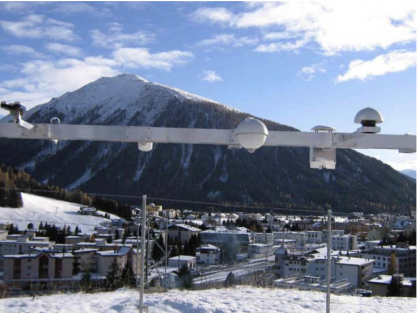What is radiation? What types of radiation are there?
Radiation is the propagation of particles or waves. In meteorology, a distinction is made between short-wave solar radiation and long-wave terrestrial radiation. The shorter the wavelength, the higher the transported energy. The visible light is part of the short-wave radiation. Examples of long-wave radiation are infrared or thermal radiation or radio and microwaves. In Figure 1, the short-wave solar radiation is shown in yellow and the long-wave terrestrial radiation in red.

Figure 1: Overview on irradiation on earth
The radiation is differentiated into:
- Global radiation (short-wave downwards (KW ↓))
- Direct and diffuse (scattered) radiation
- Reflection of short-wave radiation (short-wave upwards (KW ↑))
- Terrestrial radiation (long-wave upwards (LW ↑))
- Atmospheric counter radiation (long-wave downwards (LW ↓) - also called greenhouse effect)
Connected to the short-wave radiation there are some further important definitions:
Global radiation (GHI): Global radiation refers to the entire short-wave radiation that hits the (horizontal) surface of the Earth. This can be divided into its components: the direct and the diffuse radiation.
Diffuse radiation (DIF): Here, only the diffuse light of the sky is measured with a pyranometer, covering the sun with a shadow projector.
Direct radiation (DIR): Direct horizontal radiation is usually not measured but calculated from diffuse and global radiation.
Direct normal irradiation (DNI): Direct normal irradiation refers to radiation which hits the instrument at right angles, i.e. the direct radiation on a surface perpendicular to the position of the sun. This radiation is measured by a pyrheliometer and can be a multiple of the direct radiation on a horizontal surface, especially when the sun is shallow (see measuring instruments).
How is radiation measured?
Radiation is measured in units of watts per square meter (W/m2). For this purpose, a so-called thermopile is used in most measuring instruments. It consists of a black, conductive material that absorbs all incident radiation and converts it into heat. The more radiation that hits the black thermopile, the warmer it gets. The material used must also have a conductivity proportional to the temperature. Thus, the total radiation can be determined from the voltage difference to the 0-value. The principle is similar to that of an electric thermometer.
How should a radiation measuring device be set up?
For all devices that measure radiation, the most important thing is that the sky is not obscured in any direction. The devices must be placed in such a way that they have a direct line to the sun at all times of the day between sunrise and sunset and in all seasons, so that the radiation can hit the measuring instruments without any changes, i.e. the sensor will never be shaded all year round. In addition, it must be ensured carefully that there are no bright or glazed walls / objects in the vicinity, as these reflect the light (the radiation) and can thus impact the measurement considerably.
Difficulties with radiation measurements

Figure 2: Pyranometer
In locations with a lot of snow, directly on the sea or near glazed building fronts, reflections can radically influence the radiation measurements. Shadow casting is also often a significant source of error near measuring masts or buildings.
The biggest problem with radiation measurements is the pollution of the sensors by dust or other particles. Since the sensors are very sensitive and even the smallest dirt can absorb or reflect radiation, the measurement result is strongly distorted. The devices are therefore very maintenance-intensive, because they need to be cleaned manually on a regular basis.
Which measuring instruments are used for which type of radiation?
Short-wave radiation (both ↑ and ↓, direct and diffuse):
- Pyranometer: It measures all short-wave radiation on a horizontal surface. There are usually two devices used, one for the global radiation and one for the albedo, i.e. the ability of the surface to reflect the radiation.

Figure 3: Pyrheliometer
SW ↓ direct:
- Pyrheliometer: it is installed on a Sun Tracker and always follows the position of the Sun, so it captures only the direct normal radiation (always at right angles to the Sun).
SW ↓ diffuse:
- Pyranometer with a shadow projector. The Shadow projector is also connected to a Sun Tracker and is always directly between the Sun and the Thermopile. Thus, no direct, but only diffuse radiation can reach the meter.
Long-wave radiation (both ↑ and ↓):
- Pyrgeometer: it measures all long-wave radiation on a horizontal surface. Here, too, two devices are used, one for the radiation of the Earth and one for the reflected radiation from the atmosphere (greenhouse effect).
The combination of 2 pyranometers and 2 pyrgeometers is called pyrradiometer. This measures the complete short- and long-wave radiation and thus the entire radiation balance.

Figure 4: Weather station in Davos
The national weather service of Switzerland, MetoSwiss, and much of the Baseline Solar Radiation Network BSRN use pyrano- and pyrgeometers from Kipp and Zonen for radiation measurements. They are installed horizontally and thus measure global radiation and terrestrial radiation.
Due to the increasing use of solar energy systems, further types of sensors, such as photovoltaic reference cells have become available and quite widespread. However, due to the lack of high accuracy, these are rather unsuitable to be used for meteorological purposes.
How many measuring stations are there?
MeteoSwiss operates 133 automatic weather stations that measure the radiation. On a global scale, the BSRN operates 68 quality-controlled measuring stations worldwide and collects and processes the data. Their stations were selected because they represent the region in which they are spatially very well and have proven to meet very high quality standards. Compared to other weather parameters, there are far fewer measuring stations because the sensors are very expensive and the operation requires a large amount of personnel, which means that many measurement data are also not reliable.
meteoblue uses data from about 200 measurement stations distributed worldwide for validation and calibration purposes.


